| Author |
Message |
|
Russ Ellis
Industry Professional
|
 Posted: Fri 14 Oct, 2005 6:33 am Post subject: Posted: Fri 14 Oct, 2005 6:33 am Post subject: |
 |
|
| Daniel Staberg wrote: | | Russ Ellis wrote: | Okay so it seems that we agree that the pollaxe is not a peasant weapon.
So the only question that remains is the original one that started this thread. Was the pollaxe used in battle?
Waldman says no. I tend to believe him because period art (lack of pollaxes) and logic (pervasiveness of halberds) tend to support him. Several of your gentlemen here say it isn't so. If you could provide documentation to support that position I've got some background on a review to rework.  |
I've already provided such sourcing, I'll repeat it again.
The Bretton 15th Century instructions on how troops were to be armed, Indetures for english men-at-arms serving in France during the 15th Century, works of art, (Rous roll, the Caesar tapestries, 15thC editions of Froissart, Schilling Chronicle and so on). The research of Andrew Boardman, David Edge, Paul Knight and Crhistopher Gravett all show the poll axe in battle field use among the French and English men-at-arms.
Waldman is obviously looking at the Swiss and to some extent German praticies which were diffrent fromt he Anglo-French ones. The Halberd was for a long time only in mass use in Switzerland and througout parts of Germany while other pole arms were favoured in other parts of Europe. The halberd only became a common sight all over europe in the last decade of the 15th Century and the early 16th Century.
The Swiss didn't have a lot of men-at-arms and the German men-at-arms never adopted the habit of fighting on foot as the French and English did hence the pole axe would not have been a common a weapon in those areas and there it might very well have been used only in judical duels or in chivalric displays in the lists. |
I'm sorry Daniel I must have inadvertantly overlooked your sourcing in your initial posts. I have no idea how difficult 15th century additions of Froissart are to come by but I'll check. For the more modern stuff I was hoping for a reference to a specific book or article but the names of the authors will do I'll see what I can find. It's a bit of a disappointment to me that Waldman would myopically focus on what the Swiss were doing especially since he never states that as far as I recall, but I'll be happy to find some research that would reinstate the pollaxe as a battlefield weapon.
TRITONWORKS Custom Scabbards
|
|
  |
 |
|
Russ Ellis
Industry Professional
|
 Posted: Fri 14 Oct, 2005 7:07 am Post subject: Posted: Fri 14 Oct, 2005 7:07 am Post subject: |
 |
|
Alright as it turns out Froissart was pretty easy to find as were books by the other authors. Thanks again Daniel, apparently I have some more pole arm reading to do...
TRITONWORKS Custom Scabbards
|
|
  |
 |
Jean Thibodeau

|
 Posted: Fri 14 Oct, 2005 1:42 pm Post subject: Posted: Fri 14 Oct, 2005 1:42 pm Post subject: |
 |
|
Russ;
This sort of makes me think of when someone reads a 19th century book on arms and armour and is left with a mix of good information and a few ideas that were just someone's best guess stated as a certainty! I.E. All the strange ringmaille / banded maille schemes invented to explain what was just artist's shortcuts at drawing maille. Violet Le Duc as an example ( Spelling ? )
I haven't seen Waldman's book so I don't know what my reaction to it would be but I would try to separate what is certain fact and was is opinion based more on jumping to conclusions or inventions of the author that seem to fit the facts according to him. ( Not an attack on the author, just the caution of being careful of taking one source as gospel.   ) )
If the book has a lot of good picts of Polearms it should be worth it just for that.
You can easily give up your freedom. You have to fight hard to get it back!
|
|
  |
 |
|
Russ Ellis
Industry Professional
|
 Posted: Fri 14 Oct, 2005 1:44 pm Post subject: Posted: Fri 14 Oct, 2005 1:44 pm Post subject: |
 |
|
Yep, it's always chancy basing your opinions on a single source. I'm happy to look at others though. I'll be posting my conclusions here once I've done the research.
TRITONWORKS Custom Scabbards
|
|
  |
 |
Benjamin H. Abbott

|
 Posted: Fri 14 Oct, 2005 4:04 pm Post subject: Posted: Fri 14 Oct, 2005 4:04 pm Post subject: |
 |
|
| Quote: | | It's a bit of a disappointment to me that Waldman would myopically focus on what the Swiss were doing especially since he never states that as far as I recall |
I had to give back my copy to library this morning, but I'm rather sure I remember Waldman stating his Swiss focus in the introduction or one of the earlier chapters.
|
|
  |
 |
|
Russ Ellis
Industry Professional
|
 Posted: Fri 14 Oct, 2005 9:35 pm Post subject: Posted: Fri 14 Oct, 2005 9:35 pm Post subject: |
 |
|
It seems you are correct:
"The arms that will be discussed most fully , are those used by the Swiss..."
It was in the introduction which I'll have to admit that I skipped in my first reading. Sigh... I hate being wrong.
TRITONWORKS Custom Scabbards
|
|
  |
 |
Jean Thibodeau

|
 Posted: Fri 14 Oct, 2005 10:05 pm Post subject: Posted: Fri 14 Oct, 2005 10:05 pm Post subject: |
 |
|
Russ;
Yes but you're smart enough to learn from being wrong and honest enough to admit it: Those who are never wrong never learn from their mistakes ( And they DO make them ! )
At the same time nobody goes out and says: " Today I'm going out and make some mistakes so that I can learn something "
  
Hummmmmmmm, maybe that book is pretty good after all in the contexts of Swiss Polearms.  
You can easily give up your freedom. You have to fight hard to get it back!
|
|
  |
 |
Daniel Staberg

|
 Posted: Sat 15 Oct, 2005 5:32 am Post subject: Posted: Sat 15 Oct, 2005 5:32 am Post subject: |
 |
|
Russ,
I was in a bit of a hurry so I only wrote the authors names, these are books I've mainly relied on but as always I've bit up bits and pieces in many places so some are probably omitted.
Andrew Boardman: "The Medieval soldier in the Wars of the Roses"
David Edge and John Paddock: "Arms and Armour of the medieval Knight"
Ian Heath: "Armies of the Middle Ages Vol 1&2"
Paul Knight: "Henry V and the conquest of France 1416-1453"
Malcolm Vale: "War and Chivalry"
Matthew Bennett "Agincourt 1415"
Christopher Gravett, multiple works, notably his books on the battles of Towton and Tewkesbury and his book on English knights 1400-1500.
Gerry Embleton and John Howe: "The Medieval Soldier"
I've attached scans of details from the Burgundian tapestries captured by the Swiss during the 1476-1477 war with Charles the Bold, Duke of Burgundy. The tapestries are today kept in Bern and there is strong evidence that some of them (the so called Caesar tapestries) were made for Duke Charles himself. While there are elements of 'fantasy' in the arms and armour shown much is clearly based of real items and it has been suggested that many of the figures were actually based on the men-at-arms and archers of Charles Ducal Guard.
Pollaxe in the Caesar tapestry shows a man-at-arms in full armour wielding a shorter pollaxe, behind him another man-at-arms is amred with a what appears to be broad bladed type XVa with a type 8 guard(?) gripped in a half-swording stance.
"Pollaxes in the Trajan tapestry" is a part from a tapestry showing the Emperor Trajan dispensing military justice, Trajan is portrayed in blackened armour and is armed with a short pollaxe while one of the men-at-arms guarding him has a long pollaxe. The lenght of this weapon would support Waldman's claim of a length of 5 feet.
Polearms in the Caesar tapestry show two men-at-arms fighting with polearms, one has a glaive, the other a shortened lance, behind one can see part of a well armoured pikeman in simpler equipment (plainer sallet, breastplate, mail standard)
Regards
Daniel
 Attachment: 116.82 KB Attachment: 116.82 KB
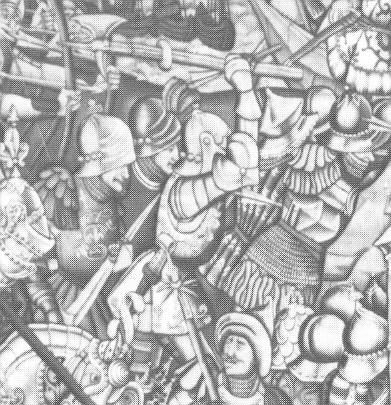
Pollaxe in the Caesar tapestry
 Attachment: 123.85 KB Attachment: 123.85 KB
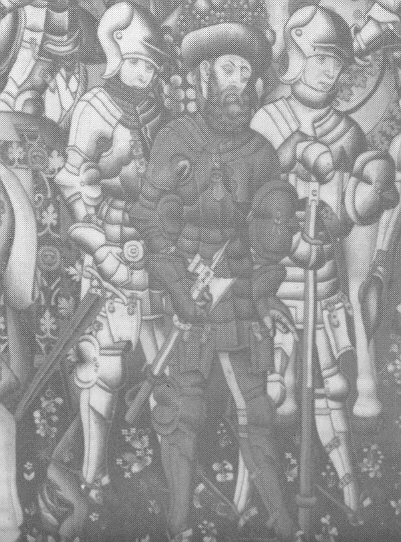
Pollaxes in the Trajan tapestry
 Attachment: 64.62 KB Attachment: 64.62 KB
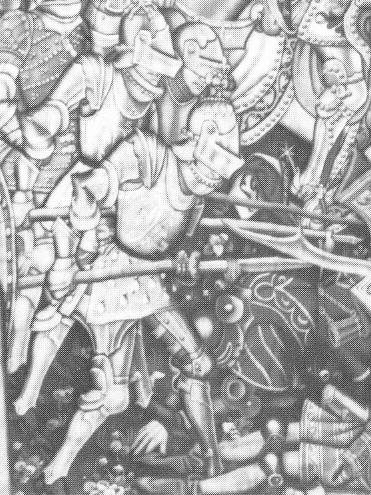
Polearms in the Caesar tapestry
|
|
  |
 |
Jean Thibodeau

|
 Posted: Sat 15 Oct, 2005 4:47 pm Post subject: Posted: Sat 15 Oct, 2005 4:47 pm Post subject: |
 |
|
Daniel;
A big thank you for those great Picts.
I think my basic question is answered about Pollaxes ( Correcting my spelling from Poleaxe: Are both O.K. ?
Side issue.  ) )
Any other Picts showing Knights or Men at Arms using a variety of Pollarms would also be interesting. ( Daniel: I think you did your part here and this is a general request to everyone else who finds good text or pictorial sources. Obviously anything more from you is more than welcome.)
You can easily give up your freedom. You have to fight hard to get it back!
|
|
  |
 |
Daniel Staberg

|
 Posted: Sun 16 Oct, 2005 8:37 am Post subject: Posted: Sun 16 Oct, 2005 8:37 am Post subject: |
 |
|
Jean,
I use 'pollaxe' as this seems to be the original with the 'poll' a reference to the hammerhead or spike fitted opposite the axeblade. AFAIk 'polearms' get their name from the long poles they are mounted on so the 'polearms' spelling is correct.
I've uploaded a few more images, the first two are men-at-arms portrayed in the Grandes Chroniques de France de St Denis dated to the end of the 14th Century while the last is an depction of the battle of Poitiers from the early 15th Century. Note such details as the shortend, 5 foot lances and what might be early forms of pollaxes in the last picture.
 Attachment: 90.35 KB Attachment: 90.35 KB
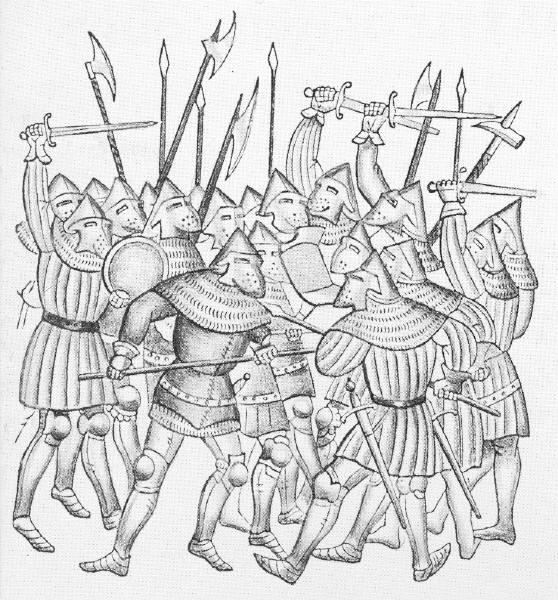
 Attachment: 62.03 KB Attachment: 62.03 KB
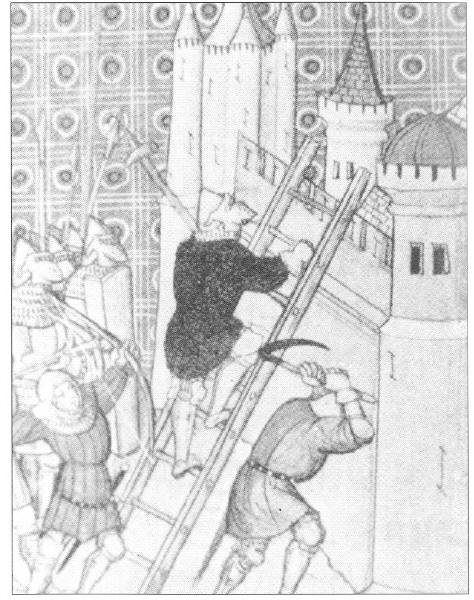
 Attachment: 58.89 KB Attachment: 58.89 KB
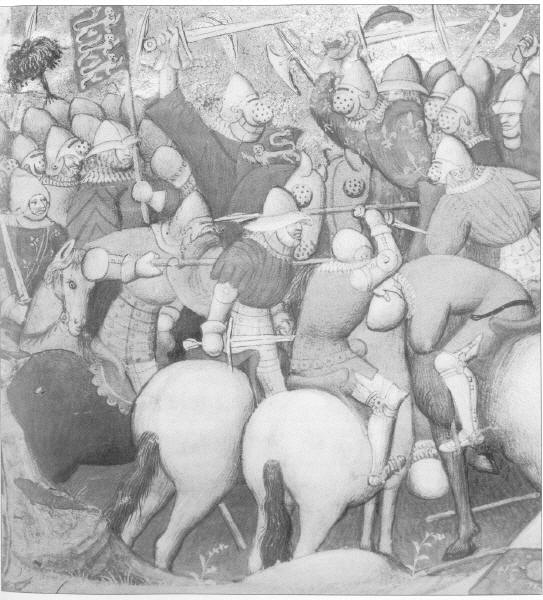
|
|
  |
 |
|
Russ Ellis
Industry Professional
|
 Posted: Sun 16 Oct, 2005 7:56 pm Post subject: Posted: Sun 16 Oct, 2005 7:56 pm Post subject: |
 |
|
LOL alright already! Thanks for the scans Daniel, if cudgelled over the head enough (perhaps someone needs to use a pollaxe) I can be made to see the error of my ways. Interestingly Waldman's book actually includes two of the first three pictures you posted there but he still for some reason draws those conclussions.  I'm at a loss as to why he would do that. Anyway in view of the preponderance of the evidence you have submitted I've amended the review. However I would like to thank you for the titles that I can buy to do more research into this fascinating subject. I'm at a loss as to why he would do that. Anyway in view of the preponderance of the evidence you have submitted I've amended the review. However I would like to thank you for the titles that I can buy to do more research into this fascinating subject.
TRITONWORKS Custom Scabbards
|
|
  |
 |
Nathan Robinson
myArmoury Admin


|
|
    |
 |
|
Felix Wang
|
 Posted: Mon 31 Oct, 2005 8:42 pm Post subject: Posted: Mon 31 Oct, 2005 8:42 pm Post subject: |
 |
|
Just to further confuse things, there is an image of mounted pollaxe use. This is from a romance, so it could be a purely fictional usage, but it does mean that someone thought about the possibility of using a pollaxe on horseback.
 Attachment: 40.95 KB Attachment: 40.95 KB

|
|
  |
 |
|
Logan L
|
 Posted: Tue 18 Mar, 2008 9:22 pm Post subject: Posted: Tue 18 Mar, 2008 9:22 pm Post subject: |
 |
|
When some one says pole axe I can only think of the halberd in my mind this weapon has an advantage in most fights. it has reach and heavy axe head and a hook on the back to trip plus a spear tip to top the axe and hook off. I would gladly carry this weapon into battle.
Dosn't mean Im right in doing so though.
Are you part of the sword or is the sword part of you.
|
|
  |
 |
|
Kelly Powell
Location: lawrence, kansas Joined: 27 Feb 2008
Posts: 123
|
 Posted: Tue 18 Mar, 2008 10:50 pm Post subject: Posted: Tue 18 Mar, 2008 10:50 pm Post subject: |
 |
|
This is entirely conjecture and opinion that has come about from playing with sca weapons and melees'....If I am showing my ignorance, please be kind when correcting me(I've had a bad week) 
The weapons they said should be 8 feet and more, in my opinion, would be formation weapons....your either trying to hook a knight off his horse or keeping busy swinging away at the enemies poll formation....the poll axe and other 6 foot weapons would be used like a sergeants short weapon in a pike push....you got to be able to rush in and fill a gap or exploit a opening.....Plus I'll fight with a 6' weapon against a 9' any day....The control you have over a 6' is tremendous.....even 71/2 ' s are slow to react in comparison.
imagine a knight in armor much superior to the typical grunt ...The grunts best chance is to stand by his bros and keep hacking away....A for effort, but a C for style....The knight is going to try to bust into them like a terrier in a rat pit...His best chances are to go in and keep going, cause as much havoc and ruin until the men at arms are soiling themselves...All the while looking for another rich SOB who he can knock the hell out and get some sweet,sweet, ransom.
The axe lends itself to this. It has a hook and a sufficient thrust(Kern axe style or just a few pounds of steel smashing like today's cops little battering rams) But not a lot to get hung up while he is in the thick of things.
On a side note , maybe this is why the Flemish did so well with their gudendag(sp?) They basically armed the guys WHO WERE SUPPOSED TO MILL AROUND TOGETHER with weapons that you have to run amok with for them to be effective.
Am waiting happily for this theory to be tore to shreds....For I have no problem with understanding that my weekend game and reality are two very separate things(unlike so many of my shire brothers/sisters  ) )
|
|
  |
 |
|
Lafayette C Curtis
|
 Posted: Fri 21 Mar, 2008 4:32 am Post subject: Posted: Fri 21 Mar, 2008 4:32 am Post subject: |
 |
|
| Kelly Powell wrote: | | His best chances are to go in and keep going, cause as much havoc and ruin until the men at arms are soiling themselves |
Doesn't work, because the word "men-at-arms" was used in medieval times to describe the tactical role of the warriors that we ignorant modern people would usually lump under the heading of "knights." So the men-at-arms were the heaviest boys on the battlefield, not the more lightly-equipped commoners that many modern people might associate with the term....
| Quote: | | On a side note , maybe this is why the Flemish did so well with their gudendag(sp?) They basically armed the guys WHO WERE SUPPOSED TO MILL AROUND TOGETHER with weapons that you have to run amok with for them to be effective. |
I'm not sure that we can describe the use of the godendag as "running amok." They seemed to have been specialist weapons used by picked groups of men who finished off enemies who had been wounded and/or knocked down by the spearmen/pikemen that made up the bulk of the Flemish battle-line, which means they were probably too disciplined and their battlefield actions too well-organized for them to properly "run amok."
|
|
  |
 |
|
Kelly Powell
Location: lawrence, kansas Joined: 27 Feb 2008
Posts: 123
|
 Posted: Fri 21 Mar, 2008 5:45 pm Post subject: Posted: Fri 21 Mar, 2008 5:45 pm Post subject: |
 |
|
Nice job of showing the flaws in my theory  ... I was thinking less "men at arms" and more city militia or other less trained quasi professionals.. And from that point of view.... troops not quite trained as well as a condotorri or field units...armor good, but not great,,,,,These are the troops who,in my opinion, would get issued long arms and would fight the way I was describing. If you do not have cav scaring them into a rout rhen it would be the heavily armored men at arms led by their captain and/or a knight armed with shorter poll arms and great axes and longswords going in to decimate them. ... I was thinking less "men at arms" and more city militia or other less trained quasi professionals.. And from that point of view.... troops not quite trained as well as a condotorri or field units...armor good, but not great,,,,,These are the troops who,in my opinion, would get issued long arms and would fight the way I was describing. If you do not have cav scaring them into a rout rhen it would be the heavily armored men at arms led by their captain and/or a knight armed with shorter poll arms and great axes and longswords going in to decimate them.
As for the "running amok" phrase......I was meaning the men armed with the gudandags would be showing more initiative and would be more on the offensive then what city militia would normally do.
|
|
  |
 |
Felix R.

|
 Posted: Sun 13 Apr, 2008 2:27 am Post subject: Pollaxe manuals and resources in the www Posted: Sun 13 Apr, 2008 2:27 am Post subject: Pollaxe manuals and resources in the www |
 |
|
Hello I just got a wooden pollaxe for training. Now I would like to get some input on which resources to use.
Until now I am training Fioresī longsword, some dagger and a little sword and buckler. Fiore includes some basic concepts on the usage of the pollaxe. Resources are available on www.fioredeiliberi.org
Is there some mor for the interested ones to get started with that awsome weapon?
 Attachment: 80.12 KB Attachment: 80.12 KB
[ Download ]
|
|
  |
 |
|
Reinier van Noort
|
 Posted: Sun 13 Apr, 2008 11:34 pm Post subject: Posted: Sun 13 Apr, 2008 11:34 pm Post subject: |
 |
|
The best source to start with is probably the Burgundian "Jeu de la Hache"
http://www.thearma.org/spotlight/lejeudelahache.htm
Hans Talhoffer also shows pollaxe work; and so does Paulus Kal. And there are still a few more sources (e.g. Codex Vindobonensis B 11093).
School voor Historische Schermkunsten
www.bruchius.com
|
|
   |
 |
James Barker

Location: Ashburn VA Joined: 20 Apr 2005
Posts: 365
|
 Posted: Tue 15 Apr, 2008 7:58 am Post subject: Posted: Tue 15 Apr, 2008 7:58 am Post subject: |
 |
|
I thought I would toss a little more in here though I am late to this thread:
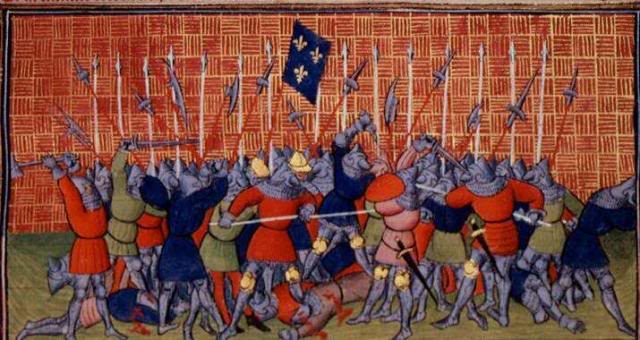
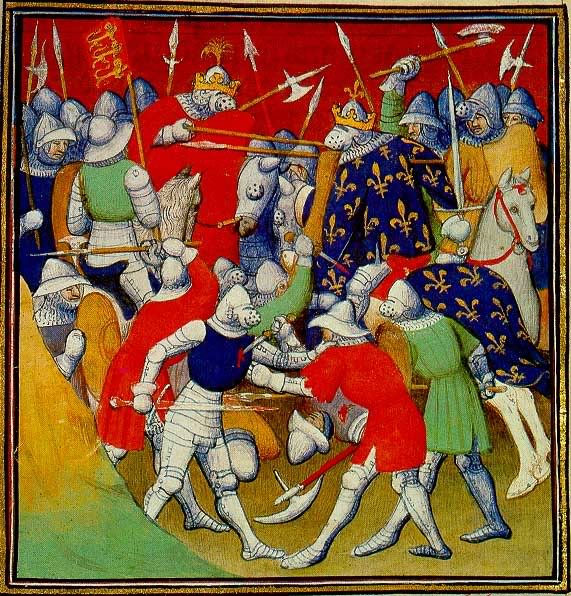
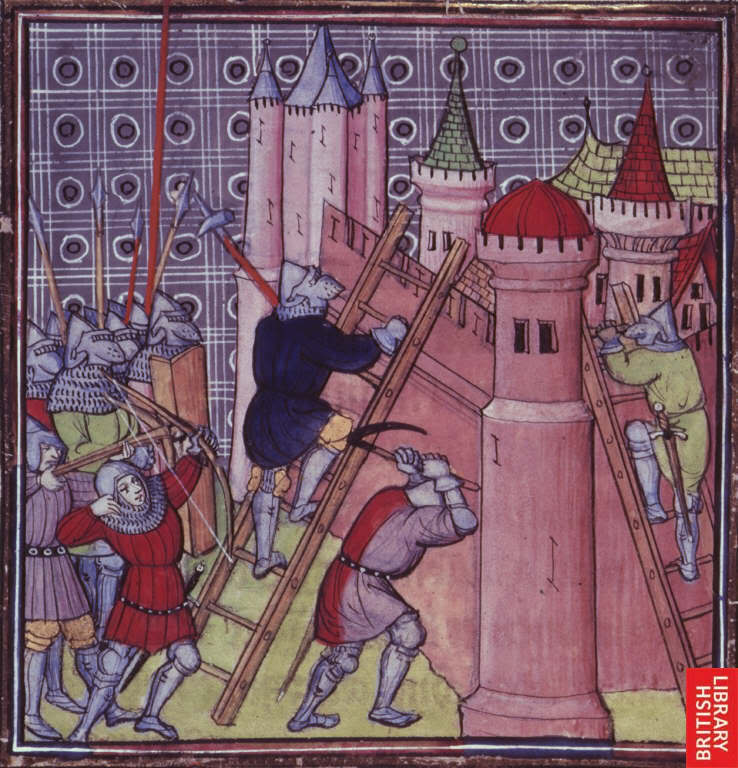
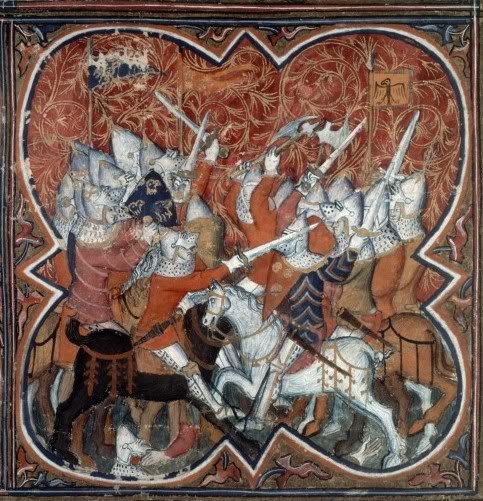
These images are too large to embed:
Hans Memeling's St. John: http://www.wga.hu/art/m/memling/2middle2/13john11.jpg
Hans Memeling's St. Ursula shrine (man in back right): http://www.wga.hu/art/m/memling/4ursula/36ursu06.jpg
Hans Memeling's Passion (back): http://www.wga.hu/art/m/memling/5late/37nogr1.jpg
One more from the Passion (soldier behind Christ): http://www.wga.hu/art/m/memling/5late/37nogr2.jpg
Axes in Deeds of Arms:
http://willscommonplacebook.blogspot.com/2006...dolfo.html
Richard Beauchamp vs. Pandolfo Malatesta 1408:
| Quote: | | How at place and day assigned, resorting thither all the country, Sir Pandolf entered the place, nine spears before him. Then, the act of spears to the earl Richard worshipfully finished, after went they together with axes, and if the lord Galeot had not the sooner cried peace, Sir Pandolf, sore wounded on the left shoulder, had been utterly slain in the field. |
http://www.nipissingu.ca/department/history/M.../monst.htm
Deeds of Arms A Collection of Accounts of Formal Deeds of Arms of the Fourteenth Century:
| Quote: | | First, to enter the lists on foot, each armed as seems best to them, having their dagger and sword upon their body as they wish, and having a pollaxe of such length as I shall give. |
http://www.thehojos.com/~stmikes/Continge.htm
Continge vs. de Bars (1415) :
| Quote: | | These arms were to be done on foot for a number of strokes; that is to say twelve strokes with the axe, twelve strokes with the sword and twelve strokes with the dagger. |
James Barker
Historic Life http://www.historiclife.com/index.html
Archer in La Belle Compagnie http://www.labelle.org/
|
|
   |
 |
|
|

